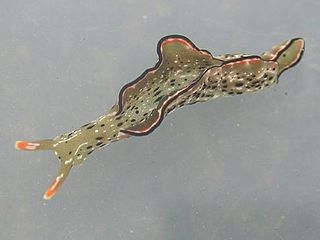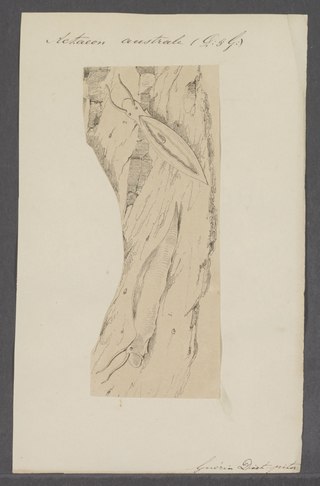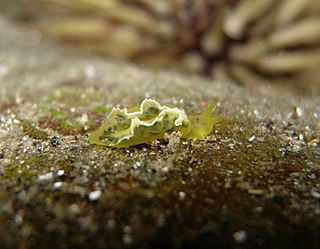
Sea slug is a common name for some marine invertebrates with varying levels of resemblance to terrestrial slugs. Most creatures known as sea slugs are gastropods, i.e. they are sea snails that over evolutionary time have either completely lost their shells, or have seemingly lost their shells due to having a greatly reduced or internal shell. The name "sea slug" is most often applied to nudibranchs, as well as to a paraphyletic set of other marine gastropods without obvious shells.

Elysia subornata is a species of small sea slug, a marine opisthobranch gastropod mollusk in the family Plakobranchidae.

Elysia viridis, the sap-sucking slug, is a small-to-medium-sized species of green sea slug, a marine opisthobranch gastropod mollusc in the family Plakobranchidae.

Elysia is a genus of sea slugs, marine gastropod molluscs in the family Plakobranchidae. These animals are colorful sea slugs, and they can superficially resemble nudibranchs, but are not very closely related to them. Instead they are sacoglossans, commonly known as sap-sucking slugs.

Elysia ornata, commonly known as ornate elysia or ornate leaf slug, is a species of sea slug, a marine gastropod mollusk. This sea slug superficially resembles a nudibranch, yet it does not belong to that suborder of gastropods. Instead it is a member of the closely related clade Sacoglossa, the "sap-sucking" sea slugs.

Elysia timida is a species of sacoglossan sea slug, a marine opisthobranch gastropod mollusk. Found in the Mediterranean and nearby parts of the Atlantic, it is herbivorous, feeding on various algae in shallow water.

Elysia pusilla is a species of small sea slug, a marine gastropod mollusk in the family Plakobranchidae. It is a sacoglossan.
Kikutaro Baba was a Japanese malacologist. He was the leading researcher on sea slugs and bubble snails, opisthobranch gastropod mollusks in Japan.

Elysia catulus is a small species of sea slug, a marine gastropod mollusc in the family Plakobranchidae. This sea slug resembles a nudibranch, but it is not closely related to that order of gastropods, instead it is a sacoglossan. The specific name "catulus" comes from the Greek and means "little cat", referring to the superficial resemblance that the head of this slug bears to the head of a cat.

Elysia margaritae is a species of sea slug, a marine gastropod mollusc.
Elysia lobata is a species of sea slug, a marine gastropod mollusc in the family Plakobranchidae. This sea slug resembles a nudibranch, but it is not closely related to that order of gastropods, instead it is a sacoglossan.

Elysia australis is a species of sea slug, a marine gastropod mollusc in the family Plakobranchidae. This sea slug resembles a nudibranch, but it is not closely related to that order of gastropods, instead it is a sacoglossan. It occurs in Australia.

Elysia obtusa is a species of sea slug, a marine gastropod mollusc in the family Plakobranchidae. This sea slug resembles a nudibranch but is not closely related to that order of gastropods, instead it is a sacoglossan.

Elysia diomedea is a species of sea slug, a marine gastropod mollusc in the family Plakobranchidae.
Elysia rufescens is a species of sea slug, a marine gastropod mollusc in the family Plakobranchidae. This sea slug resembles a nudibranch but is not classified in that order of gastropods, instead belonging to a closely related clade, Sacoglossa, the "sap-sucking" sea slugs. This species was first described by Pease from Tahiti in 1871.
Elysia serca, the seagrass elysia or Caribbean seagrass elysia, is a species of sea slug, a marine gastropod mollusc in the family Plakobranchidae. Although this sea slug resembles a nudibranch, it is not a nudibranch; it belongs to the clade, Sacoglossa, the "sap-sucking" sea slugs. It was first described by Marcus in 1955 from specimens found in Brazil.

Elysia bangtawaensis is a species of sea slug, a marine gastropod mollusc in the family Plakobranchidae. Although this sea slug resembles a nudibranch, it is not a nudibranch but is part of a rather different clade, the sacoglossans, also known as the "sap-sucking" sea slugs.
Elysia abei is a species of sea slug, a marine gastropod mollusc in the family Plakobranchidae. They are found off the Pacific coast of Japan in Sagami Bay.

Elysia grandifolia is a species of sea slug, a marine gastropod mollusc in the family Plakobranchidae native to the waters off southern India and Sri Lanka. It has colonised the waters of the eastern Mediterranean Sea.

Elysia amakusana is a species of sea slug, a marine gastropod mollusc in the family Plakobranchidae.














